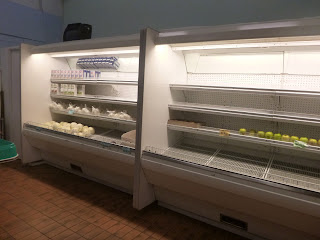Pohnpei is a roughly circular island, 14 miles wide, located about a 1,000 miles east of Guam and 3,000 miles southwest of Hawaii. It's 6 degrees north of the equator in the area northeast of Australia and the Solomon Islands. It's pretty much in the middle of nowhere.
Getting things here is always a struggle, especially perishable items like fruit and vegetables. Some things have grown here for thousands of years. Starchy tropical root crops like yams, taro, and cassava (manioc). Tropical fruit trees like breadfruit, jackfruit, and mangoes. Giant macro herbs like bananas. There are also non-native fruit species that were introduced in the last 100 years and have thrived, such as key limes, pineapples, papaya, guava, soursop, starfruit (carambola), mountain apples, green tangerines, and green oranges.
When Pohnpei and most of the other islands in the Western Pacific were the territory of the Japanese Empire--from 1914 to 1945--a lot of new things were brought in and successfully cultivated on the island. Cucumbers, squash, melons, cabbages, spinach-like leafy greens, beans, cacao, coffee, tomatoes, carrots, onions, peppers, and even rice. The Japanese were determined to make these things work--and they frequently succeeded with a lot of hard work and experimentation. So, it can be done.
But since '45, there haven't been many spirited efforts to grow non-native food crops on Pohnpei. When people do grow tomatoes or peppers or beans, they often do so just for themselves; the items aren't widely available in stores and markets. There are many more "farmers' markets" than there used to be--I can think of at least three or four off-hand that are thriving--but it's hard to predict what they will have at a given time. Sometimes you see local peppers, green onions, cucumbers, sweet potatoes, types of squash, and string beans. At other times, you will only find local root crops, breadfruit, and limes.
 So, there you have it. Those of us who feel we need a wide range of fresh veggies in our diets--a wide range of food and culinary traditions in general--must find a way to make it happen. I'm Italian. I dig fresh tomatoes and fresh basil and sage and parsley. I love greens, salads, colorful stuff. I've traveled and lived all over the world. I love food from every part of the globe. I like to mix it up when it comes to my diet. Fish is great--especially here (at about $1.00 per pound for fresh tuna)--and rice is fine, too. But after seven years in the islands and two in East Asia, I've eaten plenty of rice and fish and those things alone don't make me excited to eat. I want to be excited to eat again. I want to look forward to meals. That's why I'm doing this.
So, there you have it. Those of us who feel we need a wide range of fresh veggies in our diets--a wide range of food and culinary traditions in general--must find a way to make it happen. I'm Italian. I dig fresh tomatoes and fresh basil and sage and parsley. I love greens, salads, colorful stuff. I've traveled and lived all over the world. I love food from every part of the globe. I like to mix it up when it comes to my diet. Fish is great--especially here (at about $1.00 per pound for fresh tuna)--and rice is fine, too. But after seven years in the islands and two in East Asia, I've eaten plenty of rice and fish and those things alone don't make me excited to eat. I want to be excited to eat again. I want to look forward to meals. That's why I'm doing this.








.jpg)







exactly ! :-) come on people , time to start learning how to grow our own produce !
ReplyDelete